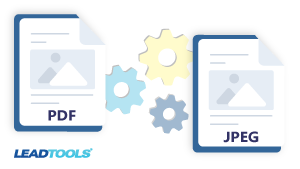
Our support department recently responded to a request for a code sample to convert PDF to JPEG. The customer needed to leverage LEADTOOLS to split and convert thousands of PDF files into single page JPEGs.
JPEG images are universal and can be loaded by practically any client on any operating system. If the PDF files are photos, JPEG is the perfect universal image format for conversion. JPEG is designed specifically for photo images, supporting 24 bits per pixel color and 8 bits per pixel grayscale data.
If the PDF files are text based and need to be converted to a universal image format, PNG and GIF are more appropriate. PNG and GIF support fewer bits per pixel, including 1- and 4-bits and leverage lossless compressions. These factors result in less data to be compressed and clearer images of text and clip art. Typically, PNG results in smaller file sizes when compared to GIF.


